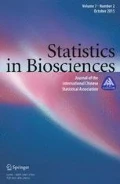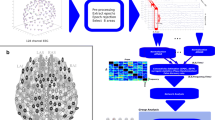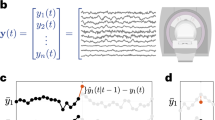Abstract
Our goal is to model and measure functional and effective (directional) connectivity in multichannel brain physiological signals (e.g., electroencephalograms, local field potentials). The difficulties from analyzing these data mainly come from two aspects: first, there are major statistical and computational challenges for modeling and analyzing high-dimensional multichannel brain signals; second, there is no set of universally agreed measures for characterizing connectivity. To model multichannel brain signals, our approach is to fit a vector autoregressive (VAR) model with potentially high lag order so that complex lead-lag temporal dynamics between the channels can be captured. Estimates of the VAR model will be obtained by our proposed hybrid LASSLE (LASSO \(+\) LSE) method which combines regularization (to control for sparsity) and least squares estimation (to improve bias and mean-squared error). Then we employ some measures of connectivity but put an emphasis on partial directed coherence (PDC) which can capture the directional connectivity between channels. PDC is a frequency-specific measure that explains the extent to which the present oscillatory activity in a sender channel influences the future oscillatory activity in a specific receiver channel relative to all possible receivers in the network. The proposed modeling approach provided key insights into potential functional relationships among simultaneously recorded sites during performance of a complex memory task. Specifically, this novel method was successful in quantifying patterns of effective connectivity across electrode locations, and in capturing how these patterns varied across trial epochs and trial types.



























Similar content being viewed by others
Notes
Assume \(b_k = (b_k^1,\ldots ,b_k^J,b_k^{J+1},\ldots ,b_k^q)^T\), where \(b_k^j \ne 0\) for \(j = 1,\ldots ,J\) and \(b_k^j = 0\) for \(j = J+1,\ldots ,q\). Let \(b_k^{(1)} = (b_k^1,\ldots ,b_k^J)^T\) and \(b_k^{(2)} = (b_k^{J+1},\ldots ,b_k^q)^T\). Denote Gram matrix \(\Psi = \frac{1}{n}{{\mathbb {X}}}'{{\mathbb {X}}}= \begin{pmatrix} \Psi _{11} &{} \Psi _{12}\\ \Psi _{21} &{} \Psi _{22} \end{pmatrix}\), then Irrepresentable Condition is satisfied if there exists a positive constant vector \(\eta \), such that \(|\Psi _{21}(\Psi _{11})^{-1}{{\mathrm{sgn}}}(b_k^{(1)})|\le 1-\eta \).
References
Allen TA, Morris AM, Mattfeld AT, Stark CEL, Fortin NJ (2014) A sequence of events model of episodic memory shows parallels in rats and humans. Hippocampus 24(10):1178–1188
Allen TA, Morris AM, Stark SM, Fortin NJ, Stark CEL (2015) Memory for sequences of events impaired in typical aging. Learn Mem 22(3):138–148
Allen TA, Salz DM, McKenzie S, Fortin NJ (2016) Nonspatial sequence coding in CA1 neurons. J Neurosci 36(5):1547–1563
Baccalá LA, Sameshima K (2001) Partial directed coherence: a new concept in neural structure determination. Biol Cybern 84(6):463–474
Baccalá LA, Sameshima K (2014) Partial directed coherence. In: Methods in brain connectivity inference through multivariate time series analysis, pp 57–73. CRC Press, Boca Raton
Boucquey VK, Allen TA, Huffman DJ, Fortin NJ, Stark CEL (2015) A cross-species sequence memory task reveals hippocampal and medial prefrontal cortex activity and interactions in humans. Hippocampus (submitted)
Fiecas M, Ombao H (2011) The generalized shrinkage estimator for the analysis of functional connectivity of brain signals. Ann Appl Stat 1102–1125
Fiecas M, Ombao H, Linkletter C, Thompson W, Sanes J (2010) Functional connectivity: shrinkage estimation and randomization test. NeuroImage 49(4):3005–3014
Fortin NJ, Asem JSA, Ng CW, Quirk CR, Allen TA, Elias GA (2016) Distinct contributions of hippocampal, prefrontal, perirhinal and nucleus reuniens regions to the memory for sequences of events. In: Society for Neuroscience Abstracts (San Diego, CA)
Friedman J, Hastie T, Tibshirani R (2010) Regularization paths for generalized linear models via coordinate descent. J Stat Softw 33(1):1
Han F, Liu H (2013) A direct estimation of high dimensional stationary vector autoregressions. arXiv:1307.0293
Hesterberg T, Choi NH, Meier L, Fraley C et al (2008) Least angle and l1 penalized regression: a review. Stat Surv 2:61–93
Ivanov V, Kilian L et al (2005) A practitioner’s guide to lag order selection for var impulse response analysis. Studies Nonlinear Dyn Econom 9(1):1–34
Kamiński M, Ding M, Truccolo WA, Bressler SL (2001) Evaluating causal relations in neural systems: Granger causality, directed transfer function and statistical assessment of significance. Biol Cybern 85(2):145–157
Kirch C (2007) Resampling in the frequency domain of time series to determine critical values for change-point tests. Stat Decis 25(3/2007):237–261
Kolmogorov AN (1933) Sulla determinazione empirica delle leggi di probabilita. Giorn Ist Ital Attuari 4:1–11
Kreiss J-P (1992) Bootstrap procedures for ar (co)-processes. In: Bootstrapping and related techniques: proceedings of an international conference held in Trier, FRG, June 4–8, 1990, vol 376, pp 107. Springer, New York
Liu H, Bin Y et al (2013) Asymptotic properties of LASSO + MLS and LASSO + Ridge in sparse high-dimensional linear regression. Electron J Stat 7:3124–3169
Mairal J, Yu B (2012) Complexity analysis of the lasso regularization path. arXiv:1205.0079
Ombao H, Van Bellegem S (2008) Evolutionary coherence of nonstationary signals. IEEE Trans Signal Process 56(6):2259–2266
Paparoditis E (2002) Frequency domain bootstrap for time series. In: Empirical process techniques for dependent data, pp 365–381. Springer, New York
Politis DN et al (2003) The impact of bootstrap methods on time series analysis. Stat Sci 18(2):219–230
Shao X (2010) The dependent wild bootstrap. J Am Stat Assoc 105(489):218–235
Shumway RH, Stoffer DS (2006) Time series analysis and its applications: with R examples. Springer, New York
Tibshirani R (1996) Regression shrinkage and selection via the lasso. J R Stat Soc Ser B (Methodol) 267–288
Wenjiang J, Fu WJ (1998) Penalized regressions: the bridge versus the LASSO. J Comput Graph Stat 7(3):397–416
Zhao P, Rocha G, Yu B (2009) The composite absolute penalties family for grouped and hierarchical variable selection. Ann Stat 3468–3497
Zhao P, Yu B (2006) On model selection consistency of lasso. J Mach Learn Res 7:2541–2563
Acknowledgements
N.J. Fortin’s research was supported in part by the National Science Foundation (Awards IOS-1150292 and BCS-1439267), the Whitehall Foundation (Award 2010-05-84), and the University of California, Irvine. H. Ombao’s work was supported in part by grants from the US NSF Division of Mathematical Sciences (DMS 15-09023) and the Division of Social and Economic Sciences (SES 14-61534).
Author information
Authors and Affiliations
Corresponding author
Rights and permissions
About this article
Cite this article
Hu, L., Fortin, N.J. & Ombao, H. Modeling High-Dimensional Multichannel Brain Signals. Stat Biosci 11, 91–126 (2019). https://doi.org/10.1007/s12561-017-9210-3
Received:
Accepted:
Published:
Issue Date:
DOI: https://doi.org/10.1007/s12561-017-9210-3




